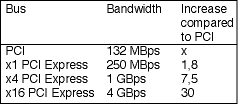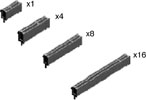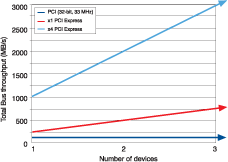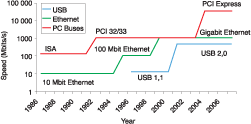
The latest technology introduced by leading PC vendors, PCI Express, is arguably the most important PC advancement in the last 10 years. This article provides a technical overview of PCI Express and discusses two use cases for this new technology.
What is PCI Express?
PCI Express is an evolution of PCI, the most popular computer peripheral bus in history. The industry consortium chartered to preserve and develop the PCI specification, the PCI Special Interest group (PCI-SIG), developed PCI Express to address bandwidth requirements of new applications for peripheral devices such as Gigabit Ethernet, modular storage devices, and video and audio intensive consumer electronics devices. To ensure adoption, PCI Express also maintains complete software compatibility with existing OSs, and PCI-based applications. PCI Express is designed to replace the accelerated graphics port (AGP) port developed to address PCI bandwidth limitations. PCI Express delivers audio and video bandwidth for the next generation of PCs, software compatibility to ensure mass adoption, and scalable bandwidth per device that will benefit peripheral devices that rely on the computer peripheral bus.
Computer-based measurement applications using PCI Express will take advantage of increased bandwidth, economies-of-scale available with PC technology, and the software compatibility with PCI. Certain applications areas that will benefit the most include, vision, modular storage, and high-channel-count static digital I/O.
30X the bandwidth of PCI
The available bandwidth for PCI Express scales as the lane width increases, and as shown in Table 1, the bandwidth of a x1 connector is 250 MBps. However, by creating a x4 lane width, the available bandwidth quadruples to 1 GBps, and a typical graphics card connected to a x16 connection can achieve 30X the theoretical bandwidth of the 132 MBps PCI bus today.

Technical advantages
PCI Express is a serial low voltage differential signal (LVDS) bus interconnects architecture. This serial bus architecture offers a significant technological advancement compared to the parallel 32-bit 33 MHz PCI bus. Parallel bus architectures such as PCI divide the total available bandwidth of the bus among all peripheral devices connected to the PC. With PCI, the maximum theoretical bandwidth is 132 MBps. This bandwidth is shared among all devices in the system, so the addition of new PCI devices results in lower bandwidth per device. PCI Express lanes are analogous to lanes on a highway. With PCI the road was simply a one lane bridge with traffic guards at both ends to direct traffic. PCI Express offers a complete highway with traffic in both directions and dedicated lanes where the infrastructure can be expanded to support additional traffic lanes.
The PCI Express specification defines an expandable differential interconnect that offers several key technology improvements. These include:
* 2,5 Gbps signalling frequency with defined speed increases.
* Differential serial bus architecture that provides bandwidth per device.
* Expandable lane widths that provide scalable bandwidth.
* Software compatibility with PCI.
Signalling frequency, defined speed increases
PCI Express defines a signalling frequency of 2,5 Gbps/direction with Generation 1. This signalling frequency is analogous to the clock speed of the bus, and determines the speed that data can be transferred between a device and the host. Because PCI Express is a differential serial architecture, each device on the bus receives this speed on both transmit and receive pair. The specification defines plans to increase the signalling frequency to 5 Gbps with Generation 2, and then to 10 Gbps/direction with Generation 3, which is the practical limitation of electrical signalling with copper.
Differential serial bus architecture
The bus architecture of PCI Express defines a low-voltage AC-coupled differential pair of transmit and receive signals (Figure 1). PCI Express transactions are packeted and then serialised with LVDS signalling. An additional 2-bit header is added to each 8-bit packet based on 8b/10b encoding. Each PCI Express lane offers both transmit and receive pairs that deliver bandwidth PER slot, and in both directions.

Expandable lane width
PCI Express defines an expandable lane width. This allows the bandwidth of a PCI Express link to linearly scale by simply adding additional lanes such as a x1 ('by one'), x2, x4, x8, x16, and x32 lane width as shown in Figure 2. With these additional lanes, PCI Express performance can scale as lane width increases just as traffic flow can increase with additional lanes on a highway.

Performance and bandwidth calculations for PCI Express
The theoretical bandwidth for a single PCI Express lane is a simple calculation of the clock signalling frequency and conversion from bits to bytes. For Generation 1 this is 2,5 Gbps and the conversion from bits to bytes using 8b/10b encoding. This means that for a x1 PCI Express Lane with 2,5 Gbps clock speed, there is 250 MBps per direction per lane of available bandwidth. In addition, this bandwidth is available to each slot in the system depending on the lane width of the slot. Figure 3 shows how bandwidth scales linearly as the number of PCI Express slots increases for both a x1 and x4 connection. This is in distinct contrast to PCI where the bandwidth remains constant, independent of the number of PCI slots available in the system.

Software compatibility
PCI Express delivers a significant advancement in PC peripheral bus technology, while maintaining complete software compatibility with PCI. PCI Express uses the same PCI plug-and-play (PnP) operating system software model and the same PCI software driver model as PCI uses today. The difference between PCI and PCI Express is implemented at the hardware layers (transaction, data link, and physical).
Advantages and new applications for bandwidth
PCI Express offers several technical advantages and a significant increase in available bandwidth that solves new PC-based applications. In the consumer electronics sector, PCI Express replaces the Accelerated Graphics Port (AGP), and delivers substantial bandwidth for audio- and video-intensive consumer electronics devices. The result is new multimedia capabilities for PCs to help drive PC technology into new consumer applications.
In the PC-based measurement and automation sector, PCI Express offers the bandwidth necessary to solve new demanding measurement and control applications. The first of many areas to benefit from this new bandwidth include industrial vision and high-speed communication.
In the case of industrial vision applications, bandwidth has always been a limiting factor. Even relatively high-speed peripheral buses such as IEEE-1394 still rely on the PCI bus to deliver images to the process. With new PCI Express vision products, such as National Instruments' PCIe-1429 Camera Link board, 680 MBps per direction per device of bandwidth is available across two Camera Link cables. This new bandwidth gives PC-based industrial machine vision solutions the ability to solve new applications that were not possible before PCI Express.
PCI Express is also a critical technology that is enabling Gigabit Ethernet. Without PCI Express, the bandwidth of Gigabit Ethernet would easily overwhelm the PCI bus. Gigabit Ethernet promises to deliver new performance levels for industrial Ethernet applications, making Ethernet the fastest peripheral connected to the core PC peripheral bus, as shown in Figure 4. The bandwidth increase achieved with PCI Express is necessary to support Gigabit Ethernet, and for this reason the adoption of faster Ethernet devices depends on core PC peripheral bus architectures like PCI Express.

Conclusion
Technology adoption in industrial sectors of the economy typically lags other industries. This is due to the business model where plants and factories depreciate capital assets during several years or decades of operation while only augmenting systems with new technology to increase production efficiency or for routine maintenance on existing systems. For this reason, customers in the industrial sector will continue to demand PCI-based systems to replace existing systems installed today. However, because PCI Express offers complete software compatibility with commercially available PCI and PCI-to PCI Express bridges, the opportunity also exists for managers to purchase new PC-based equipment with support for PCI and PCI Express products side-by-side. This gives plants the freedom to incorporated future technology into their systems while also preserving compatibility.
The transition from PCI to PCI Express will be a slow transition. The PC industry has seen similar transitions like the transition from ISA to PCI, which started in 1994 with the introduction of PCI. The transition from PCI to PCI Express is expected to be slower than the transition from ISA to PCI because there is no driving software advantage to move to PCI Express, like the Plug and Play model that provided an incentive for users to move from ISA to PCI. In fact, the public roadmaps available from Intel show PCI and PCI Express side-by-side on PC motherboards for the next six years.
About the author: Robert Jackson is a PXI product manager for National Instruments. Jackson focuses on industrial applications for PXI/CompactPCI as a member of the programmable automation controller (PAC) team. He holds a BS in chemical engineering from Oklahoma State University.
For more information contact NI South Africa, 0800 203 199.

© Technews Publishing (Pty) Ltd | All Rights Reserved